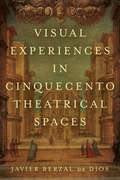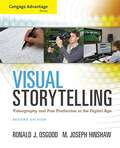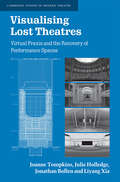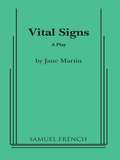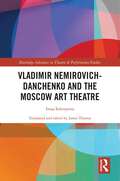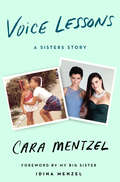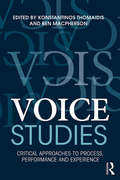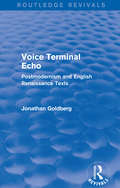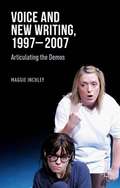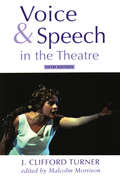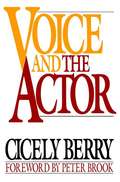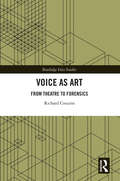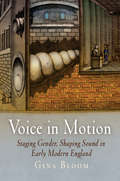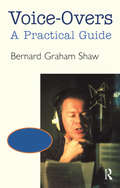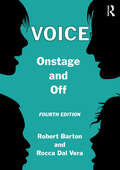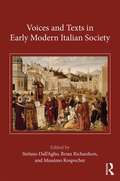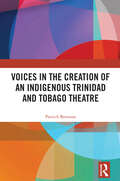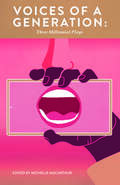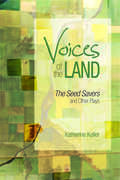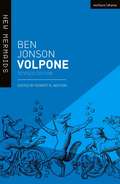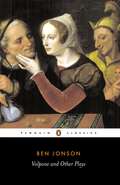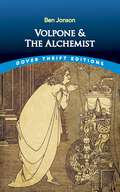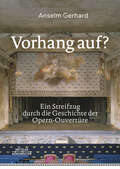- Table View
- List View
Vistas in Reading Literature (Gold Level)
by Mary Ann Trost Jacqueline L. Chaparro Judith L. Joyce Rena MoranVistas in Reading Literature, Gold Level will introduce you to a wide variety of literature. You will read stories, poems, plays, and works of nonfiction in their original forms. These works have been written by world-famous authors such as Lewis Carroll, Joan Aiken, Isaac Asimov, Jean Craighead, Langston Hughes, Yoshiko Uchida, Lloyd Alexander, and Nikki Giovanni. Some of the works may make you laugh and others may make you cry. All of them should make you think.
Visual Experiences in Cinquecento Theatrical Spaces (Toronto Italian Studies)
by Javier Berzal de DiosThrough an interdisciplinary examination of sixteenth-century theatrical spaces, Visual Experiences in Cinquecento Theatrical Spaces studies the performative aspects of the early modern stage, paying special attention to the overlooked complexities of audience experience. Examining the period’s philosophical and aesthetic ideas about space, place, and setting, the book shows how artists consciously moved away from traditional representations of real spaces on stages to conjure spectacles that pushed their collective audiences towards more imaginative, collaborative engagements no longer tethered to strict definitions of naturalism. In this way, Visual Experiences breaks with traditional interpretations of early modern staging techniques, arguing that the goal of early modern artists was not the creation of a naturalistically unified stage constructed for a single, privileged viewer, but rather a complex multimedia experience addressing a diverse set of viewers. In stressing the wider scenographic possibilities of the sixteenth-century stage, the book focuses on how space created various modes of audience engagement.
Visual Storytelling: Videography and Post Production in the Digital Age
by Ronald J. Osgood M. Joseph HinshawVISUAL STORYTELLING: VIDEOGRAPHY AND POST PRODUCTION IN THE DIGITAL AGE SECOND EDITION combines a thorough exploration of essential storytelling concepts with detailed instruction in practical technical skills. Without limiting its focus to a particular range of equipment, applications, or technology, this engaging text covers the key concepts, aesthetics, and techniques of single-camera field production and post production, and includes real-life stories and suggestions from working professionals.
Visualising Lost Theatres: Virtual Praxis and the Recovery of Performance Spaces (Cambridge Studies in Modern Theatre)
by Julie Holledge Jonathan Bollen Joanne Tompkins Liyang XiaThis pioneering study harnesses virtual reality to uncover the history of five venues that have been 'lost' to us: London's 1590s Rose Theatre; Bergen's mid-nineteenth-century Komediehuset; Adelaide's Queen's Theatre of 1841; circus tents hosting Cantonese opera performances in Australia's goldfields in the 1850s; and the Stardust showroom in 1950s Las Vegas. Shaping some of the most enduring genres of world theatre and cultural production, each venue marks a significant cultural transformation, charted here through detailed discussion of theatrical praxis and socio-political history. Using virtual models as performance laboratories for research, Visualising Lost Theatres recreates the immersive feel of venues and reveals performance logistics for actors and audiences. Proposing a new methodology for using visualisations as a tool in theatre history, and providing 3D visualisations for the reader to consult alongside the text, this is a landmark contribution to the digital humanities.
Vital Signs
by Jane MartinMonologues / Characters: 2 male (optional), 6 fScenery: Bare stage. The author of Talking With and other hits has never been funnier or more compelling than in this suite of theatrical miniatures over thirty two minute monologues. The two men in the cast are optional foils for the six compelling women who perform a collage about contemporary woman in all her warmth and majesty, her fear and frustration, her joy and sadness. Vital Signs wowed audiences at the Humana Festival at Actors Theatre of Louisville, where it was directed of Jon Jory whose notes are published with the play. . "Vital and original." N.Y. Times. . "Offers wonderful opportunities for actresses to show off their versatility." Washington Times. . "Martin's eye and ear for the texture of everyday life in this culture is as playfully accurate as Lily Tomlin and Jane Wagner's. She's a fine quipster; but she manages, too, to open little windows of sadness into women's souls." Detroit News.
Vladimir Nemirovich-Danchenko and the Moscow Art Theatre (Routledge Advances in Theatre & Performance Studies)
by Inna SolovyovaThis is an authorized translation of Nemirovich-Danchenko (Moscow, 1979) by Inna Solovyova, historian, author, and senior researcher of the Moscow Art Theatre Archives.Untranslated before now, it is the only comprehensive account of the life and work of Vladimir Nemirovich-Danchenko (1858–1943), co-founder with Konstantin Stanislavsky of the Moscow Art Theatre and one of the pioneers of the art of directing. Nemirovich-Danchenko was one of the few prominent theatre practitioners who lived and worked from Russia’s Tsarist period through the inception and consolidation of its Soviet period. Thus, it is also a story about the development of Russian society and culture during the last half of the nineteenth century and the Soviet half of the twentieth century. Additionally, it explores the Moscow Art Theatre’s interpretive and production work on the plays of Chekhov, Shakespeare, Ibsen, Dostoevsky, Leo Tolstoy, Maxim Gorky, and many others. The central theme of the book focuses on the contingent dialectical relationship between artists and their changing socio-political realities.The author’s narrative is stylistically informal and based on archival documents, most of which are referenced here for the first time in English and will be of great interest to students and scholars in theatre and performance studies.
Voice Lessons: A Sisters Story
by Cara Mentzel Idina MenzelVoice Lessons is the story of one younger sister growing up in the shadow of a larger-than-life older sister—looking up to her, wondering how they were alike and how they were different and, ultimately, learning how to live her own life and speak in her own voice on her own terms. As Cara Mentzel, studied, explored, married, gave birth (twice) and eventually became an elementary school teacher, she watched her sister, Idina Menzel, from the wings and gives readers a front row seat to opening night of Rent and Wicked, a seat at the Tonys, and a place on the red carpet when her sister taught millions more, as the voice of Queen Elsa in the animated musical Frozen, to “Let It Go.” Voice Lessons is the story of sisters—sisters with pig tails, sisters with boyfriends and broken hearts, sisters as mothers and aunts, sisters as teachers and ice-queens, sisters as allies and confidantes. As Cara puts it, “My big sister is Tony-Award-Winning, Gravity-Defying, Let-It-Go-Singing Idina Menzel who has received top billing on Broadway marquees, who has performed for Barbra Streisand and President Obama, at the Super Bowl and at the Academy Awards. The world knows her as 'Idina Menzel', but I call her 'Dee'.” Voice Lessons is their story.
Voice Studies: Critical Approaches to Process, Performance and Experience (Routledge Voice Studies)
by Konstantinos Thomaidis Ben MacphersonVoice Studies brings together leading international scholars and practitioners, to re-examine what voice is, what voice does, and what we mean by "voice studies" in the process and experience of performance. This dynamic and interdisciplinary publication draws on a broad range of approaches, from composing and voice teaching through to psychoanalysis and philosophy, including: voice training from the Alexander Technique to practice-as-research; operatic and extended voices in early baroque and contemporary underwater singing; voices across cultures, from site-specific choral performance in Kentish mines and Australian sound art, to the laments of Kraho Indians, Korean pansori and Javanese wayang; voice, embodiment and gender in Robertson’s 1798 production of Phantasmagoria, Cathy Berberian radio show, and Romeo Castellucci’s theatre; perceiving voice as a composer, listener, or as eavesdropper; voice, technology and mobile apps. With contributions spanning six continents, the volume considers the processes of teaching or writing for voice, the performance of voice in theatre, live art, music, and on recordings, and the experience of voice in acoustic perception and research. It concludes with a multifaceted series of short provocations that simply revisit the core question of the whole volume: what is voice studies?
Voice Terminal Echo: Postmodernism and English Renaissance Texts (Routledge Revivals)
by Jonathan GoldbergFirst published in 1986, this title examines a set of English Renaissance texts by Shakespeare, Spenser, Herbert, Marvell and Milton, within the theoretic framework of postmodern thought. Following an opening chapter that argues for the value of this conjunction as a way of understanding literary history, subsequent chapters draw upon Jacques Derrida’s deconstruction of photocentrism and Jacques Lacan’s analysis of the agency of the letter to offer fully theorized readings. Throughout, there is a sustained concern with the transformations of such Ovidian figures as Narcissus and Echo, Perseus and Medusa, Orpheus and Eurydice, and with the echo effects of Virgilian pastoral, as paradigms for the interplay of voice and writing.
Voice and New Writing, 1997–2007
by Maggie InchleyVoice and New Writing, 1997–2007 uses the voice as a focus for critical enquiry. It explores new writing theatres' claims to 'find' and to represent previously marginalised voices during Tony Blair's decade as Prime Minister. Hearing 'cultural evidence' for what Raymond Williams termed 'structures of feeling' in the articulation of identities, Maggie Inchley attends to the negotiation of accepted etiquettes of articulation and audibility through processes used in writing, voice training and performance. In the voices of theatre this book hears the narrative of betrayal around Anthony Giddens' 'promise of democracy', and an embattled belief in both transparency and dialogue as necessary conditions of representation. Voice and New Writing, 1997 – 2007 explores the use of voices in the work of writers including debbie tucker green, Gregory Burke, Kwame Kwei-Armah, Enda Walsh, Mark Ravenhill, and Dennis Kelly, as well as exploring the influential practice of voice teachers Cicely Berry, Patsy Rodenburg, Kristin Linklater and others.
Voice and Speech in the Theatre (Stage And Costume Ser.)
by Malcolm Morrison J. Clifford TurnerThis is a classic book on voice and speech, designed for actors at all levels. One of the great voice teachers of his day, J. Clifford Turner here uses simple and direct language to impart the necessary technical 'basics' of speech and voice.
Voice and the Actor
by Cicely BerryThere is no right way--there are only a million wrong ways, which are wrong because they deny what would otherwise be affirmed. Wrong uses of the voice are those that constipate feeling, constrict activity, blunt expression, level out idiosyncrasy, generalize experience, coarsen intimacy. These blockages are multiple and are the results of acquired habits that have become part of the automatic vocal equipment; unnoticed and unknown, they stand between the actor's voice as it is and as it could be and they will not vanish by themselves. So the work is not how to do but how to permit: how, in fact, to set the voice free. And since life in the voice springs from emotion, drab and uninspiring technical exercises can never be sufficient. Cicely Berry never departs from the fundamental recognition that speaking is part of a whole: an expression of inner life.
Voice as Art: From Theatre to Forensics (Routledge Voice Studies)
by Richard CouzinsVoice as Art considers how artists have used human voices since they became reproducible and entered art discourse in the twentieth century. The discussion embeds artworks using voices within historical and theoretical contexts in a comparative overview arguing that reproduction caused increased creativity moving from acting to creating phonic materials framed by phenomenological deep listening by early video and performance to the plurality and sampling of postmodernism and the multiple angles of contemporary forensic listening. This change is an example of how artistic practice reveals the ideologies of listening. Using a range of examples from Hugo Ball, Martha Rosler, Vito Acconci, Bruce Nauman, Janet Cardiff and Mike Kelley through to contemporary practice by Shilpa Gupta, The Otolith Group and Elizabeth Price, the voice is tracked through modernism and postmodernism to posthumanism in relation to speaking subjects, sculptural objects, documents, dramaturgical utterance, forensic evidence, verbatim techniques and embodied listening. This book gives artists, researchers and art audiences ways to understand how voices exist in between theoretical discourses, and how with their utterances, artists create new dispositions in space by reworking genres to critique cultural form and meaning. This book will be of great interest to students and practitioners of sound art, visual culture and theatre and performance.
Voice in Motion
by Gina BloomVoice in Motion explores the human voice as a literary, historical, and performative motif in early modern English drama and culture, where the voice was frequently represented as struggling, even failing, to work. In a compelling and original argument, Gina Bloom demonstrates that early modern ideas about the efficacy of spoken communication spring from an understanding of the voice's materiality. Voices can be cracked by the bodies that produce them, scattered by winds when transmitted as breath through their acoustic environment, stopped by clogged ears meant to receive them, and displaced by echoic resonances. The early modern theater underscored the voice's volatility through the use of pubescent boy actors, whose vocal organs were especially vulnerable to malfunction.Reading plays by Shakespeare, Marston, and their contemporaries alongside a wide range of late sixteenth- and early seventeenth-century texts--including anatomy books, acoustic science treatises, Protestant sermons, music manuals, and even translations of Ovid--Bloom maintains that cultural representations and theatrical enactments of the voice as "unruly matter" undermined early modern hierarchies of gender. The uncontrollable physical voice creates anxiety for men, whose masculinity is contingent on their capacity to discipline their voices and the voices of their subordinates. By contrast, for women the voice is most effective not when it is owned and mastered but when it is relinquished to the environment beyond. There, the voice's fragile material form assumes its full destabilizing potential and becomes a surprising source of female power. Indeed, Bloom goes further to query the boundary between the production and reception of vocal sound, suggesting provocatively that it is through active listening, not just speaking, that women on and off the stage reshape their world.Bringing together performance theory, theater history, theories of embodiment, and sound studies, this book makes a significant contribution to gender studies and feminist theory by challenging traditional conceptions of the links among voice, body, and self.
Voice-Overs: A Practical Guide with CD (Stage And Costume Ser.)
by Bernard Graham ShawVoice-Overs is an insider's guide to voicing radio and television commercials. Bernard Graham Shaw draws upon his nearly 20 years of voice-work experience to teach valuable studio skills and offers practical advice on how to build a voice-over career.
Voice: Onstage and Off
by Robert Barton Rocco Dal VeraThis new and updated edition of Voice: Onstage and Off is a comprehensive guide to the process of building, mastering, and fine-tuning the voice for performance. Revised with the contemporary actor in mind, this fourth edition empowers actors wishing to master their voice as performers. Every aspect of vocal work is covered, from the initial speech impulse and the creation of sound, right through to refining the final product in different types of performance. Tackling emerging discussions at the intersections of voice and identity, with new content dedicated to voice for trans and non-binary actors, as well as introducing students and practitioners to the anatomical aspects of voice and to auditory awareness, the book equips actors to hone, care for, and define their voice. Among other new features in this fourth edition are coverage of transgender acting and heightened auditory awareness, which bring this established textbook to a modern audience.This highly adaptable course of study empowers performers of all levels to combine and evolve their onstage and offstage voices.Online resources are available for each chapter, including audio examples, additional exercises, and content for instructors.
Voices
by Susan GriffinDrama \ 5f \ Unit set \ A play in poetry about the lives of five women who don't know one another, nor speak to each other. Rather they're telling their life stories to the audience. Each is facing some crisis in life. Erin speaks bitterly of suicide. Kate, near the end of a life in which she always overcame circumstances, is fearful of death. All the voices speak in counterpoint to one another, leaving an unspoken dialogue as they echo one another. The play moves in counterpoint and resonance until the women speak in chorus their voices exchanging scenes from a common history. Then each sees where her life has moved her. In the end these women's voices are no longer isolated, nor are their lives separate. Voices opened to great audience acclaim in New York City.
Voices and Texts in Early Modern Italian Society
by Brian Richardson Massimo Rospocher Stefano Dall’AglioThis book studies the uses of orality in Italian society, across all classes, from the fifteenth to the seventeenth century, with an emphasis on the interrelationships between oral communication and the written word. The Introduction provides an overview of the topic as a whole and links the chapters together. Part 1 concerns public life in the states of northern, central, and southern Italy. The chapters examine a range of performances that used the spoken word or song: concerted shouts that expressed the feelings of the lower classes and were then recorded in writing; the proclamation of state policy by town criers; songs that gave news of executions; the exercise of power relations in society as recorded in trial records; and diplomatic orations and interactions. Part 2 centres on private entertainments. It considers the practices of the performance of poetry sung in social gatherings and on stage with and without improvisation; the extent to which lyric poets anticipated the singing of their verse and collaborated with composers; performances of comedies given as dinner entertainments for the governing body of republican Florence; and a reading of a prose work in a house in Venice, subsequently made famous through a printed account. Part 3 concerns collective religious practices. Its chapters study sermons in their own right and in relation to written texts, the battle to control spaces for public performance by civic and religious authorities, and singing texts in sacred spaces.
Voices in the Creation of an Indigenous Trinidad and Tobago Theatre
by Patrick BrennanThis book explores how, from the mid-20th century, a new form of theatre emerged in Trinidad and Tobago as its playwrights came to mine the Afro-Creole Trinidadian folk milieu. This book focuses primarily on the period from the 1950s through to the contemporary moment, investigating how Trinidad’s theatrical practitioners developed methodologies that formulated an indigenous theatre. It examines how in its creation, it would distance itself from Western forms as the stage was decolonized, making way for a variety of new forms that mimetically reflect the reality of Trinidad’s Afro-Creole folk. This book establishes a premise on which the terms “folk” and “indigenous” have been shaped by Trinidad’s socio-historical past. It develops an argument that outlines how Trinidad’s African cultural retentions form a central basis on which a theatrical tradition was established.This book traces the historical impetus and driving forces that gave rise to a body of writers for whom the vitally important link between the production of drama and the search for identity in the immediacy of the post-colonial period is established. The book develops a structure that forms three lines of discrete research: folk expression, women, their portrayal and their emergence as theatrical practitioners, and theatrical developments through the decades. These subject areas are examined through the work of a broad body of playwrights. Exploring their theory and praxis, their work is described in terms that exhibit a variety of genres, with tropes that have become indelible resources for theatrical practitioners to draw from. With a theatrical base that extends from popular comedy to avant-garde spiritual works, the theatre is shown to represent a composite entity, one that accommodates a plurality of forms, which, in their summation, express the breadth and depth of Trinidad and Tobago’s theatrical journey, one that is still very much underway.Readers that have an interest in theatre, cultural, gender, post-colonial, or Caribbean studies will enjoy this book.
Voices of a Generation: Three Millennial Plays
by edited by Michelle MacArthurVoices of a Generation gathers three Canadian plays that crack open millennial stereotypes to reveal a generation’s complex and varied experiences. zahgidiwin/love by Frances Koncan follows Namid through multiple generations: as a survivor of abuse in a residential school in the 1960s, as a missing woman held in a suburban basement in the 1990s, and as the rebellious daughter of a tyrannical queen in a post-apocalyptic, matriarchal society. A comedy about loss in the era of truth and reconciliation, zahgidiwin/love uses a mash-up of theatrical styles to embody the millennial creative impulse to remix and remake while presenting a vital perspective on what decolonization might look like both on and off stage. The Millennial Malcontent by Erin Shields is a gender-swapped adaptation of Sir John Vanbrugh’s Restoration Comedy The Provoked Wife, following a group of millennials during a night out as they search for love and sex and document it all on social media. Satirizing every trope from social media stardom to economic precarity to slacktivism, Shields reveals the loneliness lurking under every smiling profile photo. In Smoke by Elena Belyea, Aiden’s ex Jordan arrives at Aiden’s door to confront her about the allegation that Jordan sexually assaulted her two years ago, forcing them to discuss their conflicting memories of their last night together and whether and how they’re going to move forward. With Jordan meant to be performed by either a cis-male or cis-female actor, Smoke is a nuanced examination of issues and perceptions surrounding sexual assault and consent.
Voices of the Land: The Seed Savers and Other Plays
by Katherine KollerThe sound of the wind across a Prairie field, the smell of grass on the first day of spring, the vocalization of birds in the early morning woods, the silence of the lake at night interrupted by call of the loon – these are the shapes and sounds of the Prairie landscape. Katherine Koller invokes the Prairie setting as a central character in each of the four plays in Voices of the Land. Serving a supportive and, at other times, antagonistic role, the landscape acts upon the characters, driving and intensifying their transformation. The land and those who live in intimate terms with it are the focus of Koller’s plays. In The Seed Savers, farmers face pressure to purchase genetically modified seed; a protagonist refuses to sell untilled land for development in Cowboy Boots and a Corsage; a dying woman sees a lake as her final resting place in Abby’s Place; and in The Early Worm Club, Millie realizes a deep sense of belonging to the Alberta parkland and its birds while searching for her mate. Nature goes beyond mere setting and backdrop in these plays to effect transformation and resolution on the characters. Ranging from romantic comedy to drama and from one-act to full-length, the plays in Voices of the Land show western Canadians at the point of leaving, returning, and renewing against the backdrop of their native landscape.
Volpone (New Mermaids Ser.)
by Ben Jonson Robert WatsonThe sharpest, funniest comedy about money and morals in the 17th century is still the sharpest and funniest about those things in the 21st. The full, modernised play text is accompanied by incisive commentary notes which communicate the devastating comic energy of Volpone's satire. The introduction provides a firm grounding in the play's social and literary contexts, demonstrates how careful close-reading can expand your enjoyment of the comedy, shows the relevance of Jonson's critique to our modern economic systems, and provides a clear picture of how the main relationships in the play function on the page and stage. <P><P>Supplemented by a plot summary and annotated bibliography, it is ideal for students of Jonson, city comedy and early modern drama.
Volpone and Other Plays
by Ben JonsonThe three plays collected in this volume depict the faults, errors and foibles of ordinary people with exuberant humour, savage satire and acute observations. Volpone portrays a rich Venetian who pretends to be dying so that his despised acquaintances will flock to his bedside with extravagant gifts in hope of an inheritance. The Alchemist also deals with greed and gullibility, as a rascally trio of confidence tricksters, claiming to have the legendary Philosopher's Stone, fool a series of victims who are hoping to make some easy money. And in a wonderfully energetic portrait of Jacobean life, Bartholomew Fair shows a diverse group of Londoners sampling the delights and temptations of the Fair - and the traders, prostitutes and cutpurses who set out to exploit them.
Volpone and The Alchemist (Dover Thrift Editions: Plays)
by Ben JonsonThese much-studied and frequently performed comedies by the great Elizabethan playwright satirize the greed, mendacity, gullibility, and pretension that Jonson saw rampant in 17h-century London society. Both plays feature colorful characters, ingenious plotting, biting wit, and sharp insight into human nature. This is the only edition to include both plays in one, inexpensive volume.
Vorhang auf?: Ein Streifzug durch die Geschichte der Opern-Ouvertüre
by Anselm GerhardDie Ouvertüre gehört zur Oper wie der Spitzenton in der höchsten Sopran- oder Tenor-Lage. Sollte man meinen. Dabei beginnt längst nicht jede Oper mit einer Ouvertüre. Dieses Buch beschreibt Erscheinungsformen und Funktionen der instrumentalen Einleitung im Musiktheater vom Barock bis in die Moderne. Der Blick ist dabei auf den Zusammenhang zwischen Eröffnungsmusik und Bühnenhandlung gerichtet, auf etwas, was in der Frühzeit der Oper gerade nicht angestrebt worden war, sich dann aber Schritt für Schritt entwickelte. So erzählt das Buch viele unbekannte Geschichten von konventionellen und vor allem unkonventionellen Lösungen, wie eine Oper eröffnet und ein Publikum zur Aufmerksamkeit gerufen wurde. Schon im 18. Jahrhundert gab es beispielsweise Pantomimen bei geöffnetem Vorhang – und zwar lange bevor ‚moderne‘ Opernregie solche Aktionen traditionellen Ouvertüren hinzuerfinden sollte. Auch davon ist, in einem Bogen von Monteverdis „Orfeo“ bis zu Brittens „Owen Wingrave“, die Rede.

